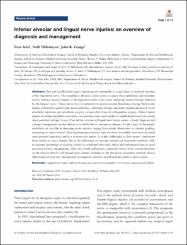| dc.contributor.author | Selvi, Fırat | |
| dc.contributor.author | Yıldırımyan, Nelli | |
| dc.contributor.author | Zuniga, John R. | |
| dc.date.accessioned | 2022-10-25T11:07:06Z | |
| dc.date.available | 2022-10-25T11:07:06Z | |
| dc.date.issued | 2022 | en_US |
| dc.identifier.citation | Selvi, F., Yıldırımyan, N. ve Zuniga, J. R. (2022). Inferior alveolar and lingual nerve injuries: An overview of diagnosis and management. Frontiers of Oral and Maxillofacial Medicine, 4. https://doi.org/10.21037/fomm-21-8 | en_US |
| dc.identifier.issn | 2664-777X | |
| dc.identifier.uri | https://doi.org/10.21037/fomm-21-8 | |
| dc.identifier.uri | https://hdl.handle.net/20.500.12511/9876 | |
| dc.description.abstract | Oral and maxillofacial surgery operations are susceptible to cause injury to terminal branches of the trigeminal nerve. The mandibular division is more prone to injury than ophthalmic and maxillary nerves. Inferior alveolar branch of the trigeminal nerve is the most commonly injured branch, followed by the lingual nerve. These nerves may be subjected to neurosensorial disturbance during third molar surgery, followed by sagittal split ramus osteotomy, endodontic therapy and dental implant placement. Local anesthetic injections, pre-prosthetic surgery, various other types of orthognathic surgery, ablative tumor surgery involving mandibular resections, osteoradionecrosis, osteomyelitis or maxillofacial trauma are among other potential etiologic factors. If an inferior alveolar or lingual nerve injury occurs, a timely diagnosis and a proper management are key factors to avoid further or permanent damage. A wide range of therapeutic modalities are available in managing nerve injuries, ranging from simple observation to complex grafting, depending on various factors. Data regarding nerve injuries may not always be reliable since most are based upon personal experience and in a retrospective nature. It is also challenging to draw proper conclusions from studies on nerve injuries due to the differences in outcome criteria and assessment methods. Still, an accurate knowledge of anatomy should be combined with both clinical and radiological data to avoid any nerve-related complications. Thus, this article will present a narrative review of the current literature on the inferior alveolar and lingual nerve injuries, focusing on the functional assessment methods, factors influencing recovery, the contemporary management protocols as well as future trends in nerve repairs. | en_US |
| dc.language.iso | eng | en_US |
| dc.publisher | AME Publishing Company | en_US |
| dc.rights | info:eu-repo/semantics/openAccess | en_US |
| dc.rights | Attribution-NonCommercial-NoDerivatives 4.0 International | * |
| dc.rights.uri | https://creativecommons.org/licenses/by-nc-nd/4.0/ | * |
| dc.subject | Lingual Nerve Injury | en_US |
| dc.subject | Inferior Alveolar Nerve Injury | en_US |
| dc.subject | Neurorrhaphy | en_US |
| dc.subject | Nerve Repair | en_US |
| dc.subject | Neurosensorial Deficit | en_US |
| dc.title | Inferior alveolar and lingual nerve injuries: An overview of diagnosis and management | en_US |
| dc.type | review | en_US |
| dc.relation.ispartof | Frontiers of Oral and Maxillofacial Medicine | en_US |
| dc.department | İstanbul Medipol Üniversitesi, Diş Hekimliği Fakültesi, Ağız, Diş ve Çene Cerrahisi Ana Bilim Dalı | en_US |
| dc.authorid | 0000-0001-9860-5494 | en_US |
| dc.identifier.volume | 4 | en_US |
| dc.relation.publicationcategory | Diğer | en_US |
| dc.identifier.doi | 10.21037/fomm-21-8 | en_US |
| dc.institutionauthor | Yıldırımyan, Nelli | |
| dc.identifier.scopus | 2-s2.0-85139473069 | en_US |



















